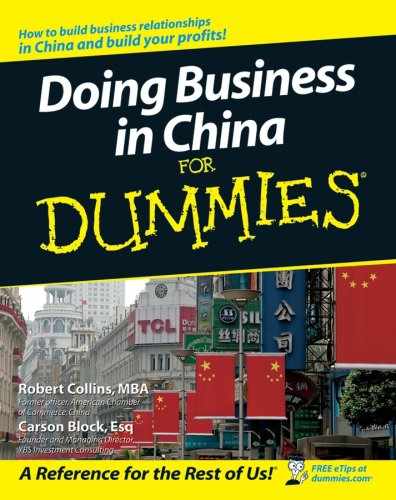Deciding How You Want to Enter the Market
You have to move quickly to keep up with China’s consumer markets, but don’t be sloppy. We discuss a few schools of thought on how to enter the market. Think about which approach is likely to work best for you.
One absolute is to have your distribution network solidly in place before trying to sell. If you don’t have your network set up well before you start to sell, your chances of failure are pretty high. So first dig your trenches and get your (or a distribution company’s) soldiers in them. In other words, first determine where you’re going to need to deploy your salespeople. Then figure out a system for organizing and scheduling their frequent customer visits. Finally, make sure they’re well trained and up for the job.

Building and scaling distribution in third-tier (and sometimes second-tier) cities is easier. See Chapter 7 for more info on location.

Guns blazing
One approach for entering the Chinese consumer market is to target several markets right off the bat, putting all your energy behind the campaign. The rationale is that competition is going to move in like lightning on your customer base, so you need to establish your presence in your target markets immediately. If you’ve set up a solid distribution network in your markets before launching, you’re halfway there.
If you use this approach, you need to think about how you can make potential mistakes as cheap as possible for you. After all, if you make some incorrect assumptions, you may screw up in several markets rather than just one. When you make mistakes on a large scale, they cost a lot more money.
Immediately targeting multiple markets will kill you if you’re doing only small volumes in each market because you won’t have the revenue to support high overhead costs related to your scale.

Starting with a beachhead
Many companies initially focus on one market, prove the model, and then expand to other markets. The Chinese are always impressed by a person or company that’s number one in some aspect, so touting your reputation as being the leader in market A can help you sell in market B. Using this model limits your risk in terms of markets and capital. The smaller scale also makes tweaking the model easier. When you use this technique, establishing your distribution first is still critical.
Putting down roots: Cinkate growin’ greatCinkate, a pharmaceutical manufacturing and sales company in China, is an excellent example of the pay-as-you-go model. Cinkate (www.cinkate.com) was founded in 1994 by Dr. James Williams, a leading U.S. surgeon, and Dr. Xiao Fei, a Chinese-born surgeon who trained with Williams. Williams and Xiao saw the opportunity to manufacture high-quality patented medicines in China at lower costs and sell them into the Chinese market. They started the company with their own funds. Cinkate found a contract manufacturer and then developed its own sales force. Initially, the company focused on only one therapeutic area and two products. As the business developed, they reinvested the profits to fund growth into new products and markets. Over the past 12 years, the company has become one of the leading pharmaceutical sales companies in China. It’s highly profitable and debt free. |
China has very few national brands, so you can take the view that any competition in other markets won’t be too strong for you to knock off when you arrive. Foreign competition, though, may be a different story.
The decision as to how quickly you expand is similar to the initial decision to begin with a beachhead rather than going in with guns blazing. The Chinese way, a pay-as-you-go system, may or may not be right for your business. This method means using the profits from the first market to get a little larger, then using those profits to get a little bit larger, and so forth.
The chief drawback of moving slowly is that your competition can leapfrog ahead of you. China is one of the most competitive, cutthroat markets in the world. Before going slowly, take stock of your company’s competitive advantages. Ask whether they’re ample to allow you to scale gradually.

Letting others blaze the trails for you
Just as in the West, you may be more comfortable moving into China on the coattails of one of your competitors. With this method, you let your competition develop awareness and demand for what you plan to offer. The competition also educates the government on your business. You sit back and study their mistakes. Finally, you go into China. You may want to go head-to-head in big markets where your competition has established itself, or you may figure that China is a big enough pie that you can each have your own slices without clashing.
For instance, U.S. do-it-yourself (DIY) home remodeling chain Home Depot was content to let its competition get to China first. In 1999, B&Q (owned by U.K.-based Kingfisher) became the first large foreign DIY store to arrive in China. B&Q quickly learned a lot of lessons about China, such as not putting higher-priced items in the front of the store (these intimidated customers into not entering) and having plenty of product samples within easy reach for customers to play with.
Not until December 2006 did Home Depot finally take the plunge into China. Home Depot announced that it would enter China by acquiring Chinese DIY retailer, Home Way. At this point, B&Q had over 50 stores in China. Home Depot appears to be betting that it can learn from B&Q’s earlier mistakes. Most interestingly, Home Depot’s strategy seems to be to buy those competitors that inevitably spring up when a company begins to develop a new market in China.
Don’t be the eighth mover. If the market is saturated, you’re likely better off not moving on it.

